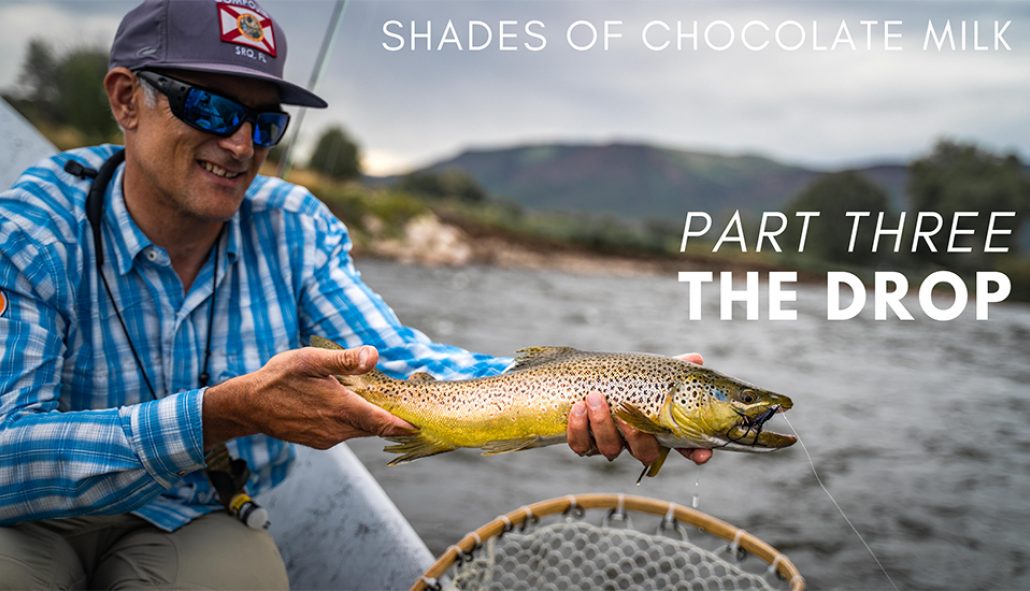Note from the Editor: We commissioned Reid Baker to pen “Shades of Chocolate Milk” - a three-part series - dedicated to fishing techniques and strategies throughout spring runoff here in Colorado. In Part I, Reid covered pre-runoff and the initial stages of this annual cycle when the rivers are starting to climb and sediments start to change water clarity. Part II focused on an extreme window when the river is peaking, and how it may be worth finding alternative locations. Now the final installment… Part III… ”The Drop.” - Will Rice
In this third part of the series, we will now focus on the timeframe after the peak, when the hydrograph starts to descend and the river isn’t the color of Yoohoo, but still not crystal clear.
What are the fish doing?
As the flows start to drop and clarity starts to improve, you can almost sense trout will have a sigh of relief. They’ve made it through the torrent of runoff, and what was likely days or weeks of limited or opportunistic feeding.
Suddenly, they can see more than a few inches in front of their face. The flows are still high, but they are not at their most violent, so fish start to move toward seams and feeding lanes. And what’s best - the high flows are stirring up lots and lots of food sources off the bottom, off debris, off the dirt banks. Some of their favorite macroinvertebrates such as stoneflies, caddis and larger mayfly subspecies are more active, perhaps hatching, provided the temperatures start to rise.
Assuming they feel comfortable and safe, they will start to feed, sometimes heavily, to make up for lost ground. This can be an exceptional time to fish, provided you recognize how to approach the river and how to find the fish.
Early season patience finally pays off
Unless rivers have dropped significantly or you’re seeing active risers, anglers should still focus on nymphs or streamers. For the dry fly enthusiasts, our days are coming shortly, and it's worth being vigilant, but it's still likely a little early to go all-in in on the dry fly technique.
If you can find yourself in a raft or dory, this is arguably the best time of year for floating and ripping streamers off the bank. Remember, higher flows push fish toward the edges. Being able to cast from the middle of the river and land your fly inches from the bank can result in near-immediate aggressive takes. Be ready to strip the second your fly hits the water.
For the bank angler, fear not, streamers can still be very effective for you as well. Start working higher in the run and allow your fly to pendulum - or swing - below you so the majority of your retrieve is downstream of your position. This keeps your streamer closer to the bank longer. Systematically work your way downstream as you feel you’ve covered the swing and retrieve effectively. For additional information on effective streamer fishing techniques, hop back to the TROUTS ARCHIVES for “5 Ways to Up Your Spring Streamer Game.”
Sink tips, polyleaders and weighted flies can help keep your presentation lower in the water column which is still key, as it was in earlier stages of runoff. This can be a great time to learn or use two handed rods, which really shine when the inability to wade out for good back casting space needs to be overcome. They can easily interchange sinking tips and effortlessly mend in long line scenarios, which makes them an incredibly effective tool in high water.
If nymphing, prioritize getting your flies down quickly and ensuring clean dead drifts. Still focus on the slower water along seams or closer to the bank. As stated earlier, many freestone(ish) rivers will have larger food sources such as stoneflies, caddis, and annelids-- aka worms, which make for very attractive subsurface presentations, especially when runoff is subsiding.
When presenting larger flies, and especially in stained water scenarios fishing deep, it does not hurt to fish heavier tippet. Because of lower water temperatures as well as general “frothiness” by being so active as the volume tumbles out of the mountains, the river has the highest dissolved oxygen content of its year usually. Dissolved oxygen means energetic fish that also have stronger current to use to their advantage. Prepare for some epic bouts and battles.
Ultimately, the time of the year after the river has peaked starts what many view as the traditional “fishing season” and is a precursor to the most active months in a river’s cycle. While July-October is without doubt primetime, the months before should be seen as equally opportune, even if your favorite river isn’t as clear or as easily waded as you see it in summer.
Click here if you missed Part I or Part II of this series.

